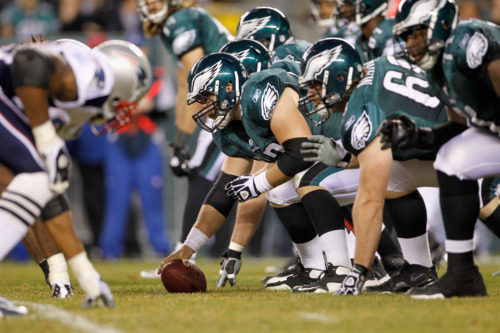If you watched the putrid Thursday Night Football game between the Giants and the Redskins last night, there was some solace for Philly fans. Mainly that everyone else in this division is pretty much just as #terrible as the Eagles.
That does leave room for optimism, despite two of the worst Eagles games in recent memory, strung back to back at the start of this season. The truth is that as bad as the Eagles have been, they still can turn things around. The question is whether their awful play so far is the result of fundamental, uncorrectable problems or something more fixable.
The answer to that question is in the eyes of the beholder. The offensive run blocking has been so bad that it's the worst (through two game sample size, of course) of any offensive line I can find in Football Outsiders' history. Their Adjusted Line Yards (aka roughly the yardage that the line is responsible for) is just 1.11 yards. To put that in perspective, last year's poor line was ranked 29th in ALY with 3.52 yards. Ryan over at ChipWagon can give you both the execution and scheme reasons for such failure.
On one hand, maybe this is a sign that with a historically-bad offensive line and questionable play calling, the Eagles will never get their run game together. On the other hand, we can probably expect the Eagles to revert back at least somewhat to the mean, making the run offense moderately usable at some point. (Optimism!)
Ditto for Sam Bradford. This is a quarterback who has endured very little pressure from defenses (just 23% of the time through two games). The offensive line, for all of its run blocking woes, has allowed just one sack, good for the 3rd-best Adjusted Sack Rate in the NFL of 1.5%. Yet Bradford continues to be unable to throw the ball down the field.
Bradford has averaged just 6.3 yards per attempt so far, 28th best in the league. To go with that, he's thrown 2 touchdowns against 4 interceptions and has looked out of sync with his receivers the whole time. Maybe Bradford is just bad, and Chip Kelly bet on the wrong quarterback. Maybe Mark Sanchez (barf) is actually the better choice right now. Or maybe Bradford hasn't played much in two years and is still adjusting to a new offense, new personnel, and being hit. Maybe he'll get better.
The defense, meanwhile, has shown promising signs (Malcolm Jenkins, Walter Thurmond, Bennie Logan) and worrisome ones (Byron Maxwell). The stats are slightly above average through the first two games against two potentially decent offenses. The defense certainly isn't good enough to carry an offense this bad, but it isn't the reason the Eagles have lost, either. More tests to come, though.
This weekend's game against the Jets is a must win. You don't go 0-3 and make the playoffs in this league. According to the chart below from FiveThirtyEight, that would leave them with just a 2% chance. But if they go 1-2, that's 25% and a tie for second place in a historically weak division. Then just maybe, there's room for hope...





